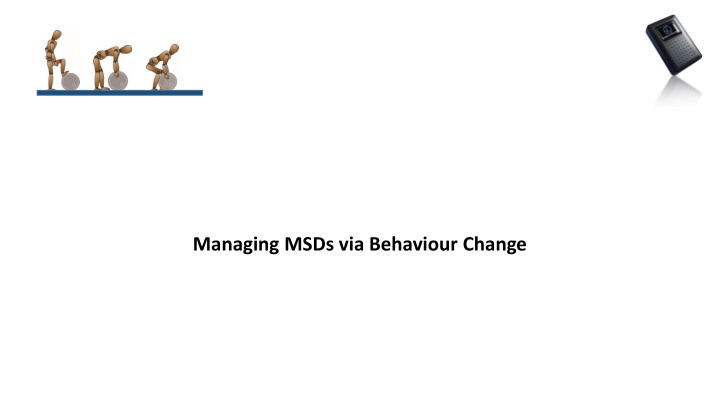



Managing MSDs via Behaviour Change
Musculoskeletal Disorders • MSDs are a huge global issue – for both employers and for individuals. • There are no easy solutions. • There is no personal protective equipment (PPE) to prevent or minimise back injuries. • Training appears to be ineffective. According to OSHA-Europe 1 , “ Training on working methods in manual handling is not effective if it is used as the only measure to prevent low back-pain ”. • The responsibility has been with the employer to resolve (and they only have a few tools to assist them) • In the UK, it is generally accepted that reductions in MSDs will only be achieved by changing an individuals working behaviours. BACK-TRACK has been designed to do exactly that. 1. European Agency for the Safety & Health at Work, Work Related Musculoskeletal Disorders, Back To Work Report .
The BACK-TRACK System – What is it? • The BACK-TRACK System incorporates a small data collection device that monitors posture (to detect stooping) and a web based management system. • As well as posture, the BACK-TRACK device monitors activity (walking) and free-fall (when jumping). • BACK-TRACK provides a vibration alert if it detects stooping, jumping or a prolonged period of inactivity. • BACK-TRACK may be used proactively i.e. to prevent injury or to manage the rehabilitation process of those returning to work following a back related absence.
BACK-TRACK device – what does it monitor? • Rotation. The BACK-TRACK is worn on a belt and the device detects that it is rotating as the wearer starts to lean and stoop forwards. At a programmed angle, the device vibrates to alert the wearer that they are stooping (the behaviour we are trying to avoid). • Freefall. The BACK-TRACK device detects free-fall which is used to detect jumping from delivery vehicles cabs and tailgates. • Activity. The accelerometer inside the BACK-TRACK device detects movement and can therefore be used to monitor activity, which is vital for rehabilitating someone with back pain. Evidence indicates that sitting at a desk for long periods will inhibit the rehabilitation of an injury 1 . 1. Williams C, Denning E, Baird A and Sheffield D. Move-more – Investigating the impact of behaviour change techniques on break taking behaviour at work Institure of Safety and Health, 2014. www.iosh.co.uk/movemore
Modifying Behaviours – The Evidence Activations / Hr (Average for All Users) 7 6 5 4 3 2 1 0 May- Jun- Jul- Aug- Sep- Oct- Nov- Dec- Jan- Feb- Mar- Apr- May- Jun- Jul- Aug- 08 08 08 08 08 08 08 08 09 09 09 09 09 09 09 09
BACK-TRACK changes behaviour in 2 ways 1. The real-time intervention provided by the BACK-TRACK device when it vibrates when it detects undesirable postures. 2. The recorded data shows if an individual is potentially at an elevated risk of injury. This promotes engagement.
The BACK-TRACK System Why are back injuries so common? Stooping is seemingly harmless and it doesn’t hurt whereas the advocated semi-squat method requires: conditioning of under-used thigh muscles balance practice (familiarity) but most importantly A CHANGE IN BEHAVIOUR !
The BACK-TRACK System changes behaviour The BACK-TRACK System behaviour change cycle. Monitor - via the BACK-TRACK device Review - monthly review of the collected data (via the automated reports) Feedback - to those identified at being at elevated risk using the 1:1 template Modify - techniques, task, methodologies, layouts, etc This process is proven to be effective for modifying Manual Handling techniques and for jumping from vehicles.
BACK-TRACK Manual Handling Competency Programme – how does it work? Assess who appears to activate their BACK-TRACK most often. These individuals are potentially at an elevated risk of injury.
BACK-TRACK Manual Handling Competency Programme – how does it work? • A simple review of their collected data is more informal, yet a very effective way of raising awareness of risk.
BACK-TRACK Case Studies • Leading UK Parcel Carrier; trial data • Detail data shows that for some drivers, most activations occur in the depot while loading the vehicle. A red line indicates an activation Loading vehicles first thing causes most activations. CG AAPH trend by week
BACK-TRACK Case Studies • DHL Tesco: DP 2013 Innovation Award winner. Reducing absence using the BACK-TRACK Competency Prog . • DHL Sainsbury’s: Using BACK-TRACK for Rehab to manage the Return-To-Work process. • DHL Life-Sciences: Workplace Assessments using BACK-TRACK and using BACK-TRACK for Rehab. • DHL Automotive: Using the BACK-TRACK Competency Prog . to reduce back, leg and ankle injuries and absence. • TNT Express: Using the BACK-TRACK Competency Prog . to reduce back, leg and ankle injuries and absence. • Allied Bakeries: Using the BACK-TRACK Competency Prog. to reduce back, leg and ankle injuries and absence. • Large UK parcel carrier: Using BACK-TRACK for Rehab and Induction.
Jump Detect (for drivers) Induction (12 wks) Many implementation options exist. Workplace Competency Assessment Programme Risk BACK-TRACK TM Screening Absence RTW Mandatory & LTA MH Training
Contact info • John Pelling, Managing Director • Tel: +44 7748 327773 • Email: john.pelling@backtrack.co.uk • BACK-TRACK Europe Ltd., 1 Emperor Way, Exeter, EX1 3QS, UK
Recommend
More recommend